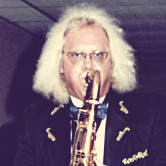Foreword by Paul Coats (November 19, 1999):
I had stumbled upon Steve Goodson’s web site, while surfing the Sax Ring. The more I looked at his site, the more interesting it became. Since New Orleans is only a two-hour drive from my home, I contacted Steve and arranged a time for a visit. We spent half a day exchanging ideas, and I learned much more from him than he from me, we found we had a lot of experiences in common. Steve is a real 110%’er, a full throttle type of person, and a heck of a lot of fun! As part of my “guest article” series, Steve agreed to this interview.
HOW DID YOU GET INTO THE VINTAGE HORN BUSINESS, STEVE?
Well, when I was starting out, I was too broke to buy new horns! My first alto was a 1930 Martin Handcraft, which I still own. My first tenor was a Buescher 400, which I should never have sold. My first bari was a Buescher True Tone, and my first soprano was a gold plated Conn “New Wonder”, which I deeply regret parting with! I got my first Mk VI in 1964, and still use that horn regularly. In the early 70′s I began to understand that there was something about the horns that had been played a lot and were well broken in that just couldn’t be duplicated with current production. I find that new instruments just lack that certain undefinable “personality” that you only get with a vintage example.
WHAT VINTAGE HORNS SHOULD A POTENTIAL BUYER CONSIDER, OR MORE IMPORTANTLY, AVOID?
Well, that really depends on what you’re going to do with them. If you’re gonna hang them on the wall, or make lamps out of them, then the Kings from the 20′s with that elaborate engraving are hard to beat. The Holton’s look pretty cute as well, particularly the Rudy Weidoft models. Of course, neither of these play like real saxophones, and are generally pretty useless in any type of modern music. I would caution anyone who is considering actually using a vintage horn to make real music to be very wary of anything before 1930.
Up until that time, intonation was a little sketchy, and the horns just don’t feel right in the hands and are hard to use. After 1930, there’s some really great stuff available: the Conn “Chu Berry” models have a fantastic sound. The Martin Committee models are unusually lush down low. King got it really together with the Zephyr. The Bueschers, both Aristocrat and 400, are among my favorites, particularly the 400. What a horn!
When Conn replaced the “Chu” series with the 6M alto and 10M tenor, they took a giant leap forward in intonation and playing ease. I’m not a big fan of the Selmers before the Super Balanced Action. I find that you really have to humor them to get them in tune.
SO WHERE DO YOU FIND THESE HORNS?
I’ve been at this long enough to where most of my stuff comes to me. You hear the stories about the great deals in pawnshops and on E-Bay, but those great deals are getting harder to come by. Today, there are a number of knowledgeable dealers who can help guide a novice buyer through the process. That dealer network didn’t exist until a few years ago, and now a customer can get lots of information and competent advice.
ANY TIPS ON WHAT TO LOOK FOR TO HELP DETERMINE THE TRUE CONDITION OF AN OLD SAX?
If you like the way the horn plays, and think the price is fair, buy it and ignore everything I say after this. If the engraving on the bell does not have sharp edges to the touch, and is not clearly defined, the horn has been relacquered at least once, so be careful!
YES, I NOTICED THE FIRST THING YOU DID WHEN YOU SAW MY MK VI WAS FEEL THE ENGRAVING. WHAT ELSE?
Look at the keywork on the stacks and first, be sure it’s tight with no horizontal play. Make sure that the “tubes” are of an absolutely consistent diameter. If they look a little pinched where two keys meet, then the horn has been swedged, and that’s a sign of high mileage. The pads should be smooth and flexible, with no rough edges. Take close look at the pearl holders and be sure that the metal part is not worn down. If they are, you’ve got a horn that’s too long in the tooth! The metal should be smooth on the body, not lumpy from dent removal by someone not competent to do it.
WHAT’S THE NUMBER ONE MISTAKE YOU SEE BUYERS MAKE?
They buy an old horn that is not complete and assume that they can get parts. You can’t. They don’t exist. Particularly necks. If you can find the parts, usually in the hot little hands of someone like me, I can only tell you to get out the big leather bound checkbook. If it’s not all there, don’t buy it!
IF YOU COULD OWN ONLY ONE VINTAGE HORN, WHAT WOULD IT BE?
I’m lucky in that my wife lets me buy all the horns I want for my own collection. They’re all my favorites. I wish I could have as many wives as I have saxophones, but I just don’t think Sharon would understand! I do have a favorite: the LeBlanc Rationale. A little too complex to be owned by mere mortals, but what a great design. After that, probably a Buescher 400.
WHAT DO YOU THINK ARE THE BEST BUYS FOR THE MONEY?
Martin Committee and The Martin models. King Zephyrs and Conn 10Ms with the underslung octave mechanism and nickel keywork. You can pick them up, the Conns at least, at bargain basement prices.
ANY FINAL WORDS OF WISDOM FOR POTENTIAL BUYERS, STEVE?
Yeah. Learn all you can. Be realistic about what these horns cost in the market place. Understand that old does not necessarily mean good. Look at any horn literally with a magnifying glass. I do! Believe me when I tell you that pictures you see on the internet are not sharp enough to tell you what you need to know to make a final decision. Modern mouthpieces, particularly the high baffle ones currently in vogue, often do not work on vintage horns. A $1000 Conn 10M that needs an overhaul is probably not a bargain. There’s a huge amount to learn, and generally lots of folding money on the table, so take the time to educate yourself!


